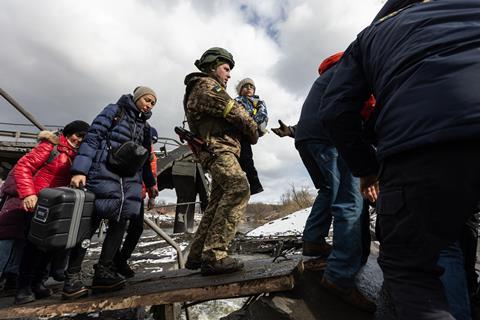Evgeny Afineevsky assembles urgent, immediate footage from the Ukraine front

Dir: Evgeny Afineevsky. US. 2022. 118 mins.
When Russia launched its invasion of Ukraine in February of this year, Evgeny Afineevsky’s 2015 Netflix documentary Winter on Fire, about the 2013-14 Maidan protests in Kyiv, had a new lease of life for those wanting background on the Ukrainian situation. The Israeli-American documentarist now follows it with the awkwardly titled Freedom On Fire: Ukraine’s Fight For Freedom, which could equally serve as a vital primer for the events of the last few months. Mixing often horrifying war footage with testimonies from a wide range of Ukrainians of varying ages, Freedom on Fire is an urgent, somewhat hectic, at times cluttered film – but that’s partly explained by the fact that Afineevsky has been able to assemble it so rapidly, only six months after the invasion began. There will be other, more sober, comprehensive or detached documentaries about this topic – but as an urgent evocation of the enormity of these events, and a homage to the resilience of the Ukrainian people, Freedom on Fire is a film that deserves to be widely seen, and as soon as possible, while its account is still absolutely of the moment.
The film offers a sometimes horrifying anthology of scenes of destruction and ruin, of a sort which might be expected to result in despair: “We apparently live in the twenty-first century, but we’re fighting in the Middle Ages,” says one man
Freedom on Fire only partly serves as a history lesson: early on, there’s a historical sketch of several hundred years of Ukrainian history, with animations and voice-over narration by Helen Mirren. But what follows isn’t chronological; in fact, till some 40 minutes in, there’s no mention of the separatist regions of Donetsk and Luhansk, whose independence, announced by Putin in February, essentially marked the start of the invasion.
Working with a substantial roster of cinematographers, gleaning material from assorted Ukrainian cities, Afineevsky offers interview testimonies from a wide range of sources. A key voice throughout, also seen conducting her own TV news reportage, is Nataliia Nagorna, a journalist for Ukraine’s 1+1 news channel; another is Catholic priest and military chaplain Father Andriy Zelinskiy; while Anna Zaitseva is a young woman who sheltered for two months in Mariupol’s Azovstal steel plant, tending her baby son Sviatoslav. The youngest informant is a 7-year-old boy, Makar, one of several pre-teen voices: the film consistently foregrounds the presence of children, not so much to tug our heartstrings (although that’s certainly one effect) as to bring home the stakes of the conflict on a daily domestic level.
The film offers a sometimes horrifying anthology of scenes of destruction and ruin, of a sort which might be expected to result in despair: “We apparently live in the twenty-first century, but we’re fighting in the Middle Ages,” says one man. But the national sense of focus, determination and indeed, insightfulness as opposed to only anger, is very palpable: “to stay human is the most important part,” comments Father Zelinskiy. Nagorna comments that war is incomprehensible, “not from our world”; but interviewees often prove very adept at reading the national predicament. There’s some analysis undertaken of just how it is that many Russians espouse Putin’s brutal cause: Ukrainians are critically aware of the effects of propaganda (including Russian media’s attempts to discredit Ukrainian war footage as fake); one soldier notes that if older Ukrainian citizens in some regions have supported Russia, it’s because they still identify it with the USSR, which was powerful in their youth.
Freedom on Fire can sometimes feel like a chaotic accumulation of information from different cities, each named in Ukrainian, Russian and English captions. But the film is intensely powerful not least in presenting us with a saturation of material for a straight two hours – more than most of us are accustomed to watching in one go on the TV news. The footage mainly comes to us neat, although for artistic effect, still images of an often highly dramatic nature are interpolated with added 3D-style effects (the ‘Ken Burns Effect’, as it has come to be known).
Production companies: Winter on Fire Production, MakeMake Entertainment
International sales: The Gersh Agency, bwalker@gersh.com
Producers: Evgeny Afineevsky, Will Znidaric, Ted Hope, Galyna Sadomtseva- Nabaranchuk, Shahida Tulaganova , Inna Goncharova
Cinematography: Aleksandr Ratushniv, Alex Kashpur, Alyona Gramova et al
Editing: Will Znidaric
Music: Jasha Klebe
Some images are exceptionally grim: one man, during an account of the Russian army’s summary executions of civilians in Bucha, gestures the camera towards the nearby presence of a blackened severed hand; while solider Stanislav Stovban coolly recounts his leg amputation. These horrors are offset by a hopeful, upbeat tone towards the end, notably with Anna Zaitseva recounting her joy at her baby getting to see the sky after more than two months sheltering underground. But the conflict and the pain continue: Anna’s husband, a steelworker turned soldier, became a POW in May, and the film ends with critical moments in the invasion, right up to August. This is a film that could almost be updated with every single screening; let’s hope it won’t need to be for too much longer.
























